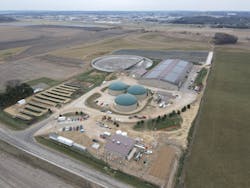Microgrid-powered facility in Wisconsin produces renewable natural gas for California
Powering an anaerobic digester project with a renewable microgrid has transformed the economics of biogas at a newly commissioned plant in Wisconsin. The facility is turning organic waste from more than 4,000 dairy cows into renewable natural gas and injecting it into a natural gas pipeline for use as a transportation fuel in California.
EnTech Solutions, in partnership with Northern Biogas, acquired the existing biogas project in Springfield, Wisconsin, then reconditioned and converted the facility to produce renewable natural gas.
The microgrid solution from EnTech includes remote monitoring, batteries, inverters and some 2.8 MW of solar PV. “Part of our strategy is making these biodigesters more profitable by harvesting on-site renewables and using a microgrid to produce more valuable renewable natural gas,” Scott Romenesko, president of EnTech Solutions, told Microgrid Knowledge.
“The facility was producing raw biogas and burning it in generators to produce electricity, with electricity being sold back to the local utility. As the existing system came close to the end of its life and the dynamics in the renewable market changed, we felt it made sense to repurpose this facility to bring more value,” Romenesko said.
The energy produced by the microgrid is used on-site to power the system, including equipment such as dryers which remove moisture from the biogas and compressors. Processed gas is then transported by truck for injection into a gas pipeline in Madison, Wisconsin, about 10 miles southeast.
“There is more value in selling renewable gas into the pipeline that is produced with renewable electricity,” said Romenesko, adding: “It all plays into the growing renewable fuels market by reducing the overall carbon footprint. The idea behind the microgrid integration is that production of the renewable natural gas is being accomplished utilizing renewable electricity.”
In the California market, every source of renewable natural gas has an associated carbon intensity score. The better that score, the more valuable that fuel is going to be in the marketplace. For every point of improvement, there is an improvement in the value of the renewable natural gas produced. Running the biogas plant and its ancillaries on renewables has an impact on that score and improves the overall value of the product because it is a cleaner fuel.
Overall, gas from dairy manure can reduce greenhouse gas emissions up to 400% when it is used to replace traditional vehicle fuels, according to EnTech, which said the facility will reduce emissions by more than 13,500 metric tons of carbon dioxide equivalent per year.
Learn more about renewable microgrid projects. Subscribe to the free Microgrid Knowledge Newsletter.
